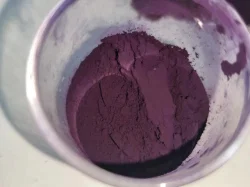Common types of paint pigments
2023-11-28
Paint pigments are substances that impart color to paint by selectively absorbing and reflecting certain wavelengths of light. Pigments can be derived from natural sources or produced synthetically. They come in various forms and types, each contributing unique characteristics to paint. Here are some common types of paint pigments:
1. Inorganic Pigments:
- Titanium Dioxide: A widely used white pigment known for its excellent opacity and brightness. It is commonly used in white and light-colored paints.
- Iron Oxides (Red, Yellow, Brown): Natural or synthetic pigments that provide a range of earthy colors, including red, yellow, and brown. They are often used as tinting pigments.
- Ultramarine Blue: A vivid blue pigment traditionally made from the semi-precious stone lapis lazuli. Synthetic versions are also available.
2. Organic Pigments:
- Phthalocyanine Pigments (Blue and Green): Intense and stable pigments commonly used in a range of colors, including blue and green.
- Azo Pigments (Red, Orange, Yellow): A family of synthetic pigments known for their bright and transparent colors.
- Quinacridone Pigments: Modern synthetic pigments with high color strength, stability, and transparency. They are used in a variety of colors, including reds and violets.
3. Carbon Black:
- A type of black pigment consisting of fine carbon particles. It is commonly used to create black paint and is also used as a reinforcing agent in rubber.
4. Metallic Pigments:
- Aluminum Powder: Adds a metallic or pearlescent effect to paints. It is often used in automotive finishes and specialty coatings.
- Bronze Powder: Provides a metallic bronze appearance to paints, often used for decorative or artistic purposes.
5. Pearlescent Pigments:
- Mica-Based Pigments: Derived from minerals like mica, these pigments create a pearlescent or iridescent effect. They are used in cosmetics, automotive finishes, and decorative coatings.
6. Fluorescent Pigments:
- Fluorescent Colors: These pigments absorb ultraviolet (UV) light and emit visible light, creating bright and vivid colors. They are commonly used in safety and signage applications.
7. Natural Pigments:
- Ochre: Natural earth pigments ranging from yellow and brown to red. They have been used in art and decoration for centuries.
- Sienna and Umber: Earth pigments with brown hues, derived from natural clays.
8. Synthetic Inorganic Pigments:
- Cadmium Pigments (Red, Orange, Yellow): Bright and opaque pigments with high tinting strength. Note that cadmium pigments have environmental and health considerations.
- Chromium Oxide Green: A durable green pigment often used in industrial coatings and artists' paints.
9. Complex Inorganic Color Pigments (CICP):
- Bismuth Vanadate: A yellow pigment known for its high opacity and durability. It is used in various coatings.
10. Interference Pigments:
- Interference Colors: Pigments that create a color-shifting effect based on the angle of observation. They are often used in automotive finishes and specialty coatings.
11. Transparency Pigments:
- Transparent Iron Oxides: These pigments offer a transparent or semi-transparent appearance, often used in glazes and transparent coatings.
12. Specialty Pigments:
- Thermochromic and Photochromic Pigments: Pigments that change color in response to temperature or light exposure, respectively. They are used in niche applications like novelty items and security inks.
When choosing pigments for paint, considerations include color intensity, lightfastness, chemical stability, toxicity, and intended use. Paint manufacturers often formulate their products with a combination of pigments to achieve specific colors, properties, and performance characteristics.



